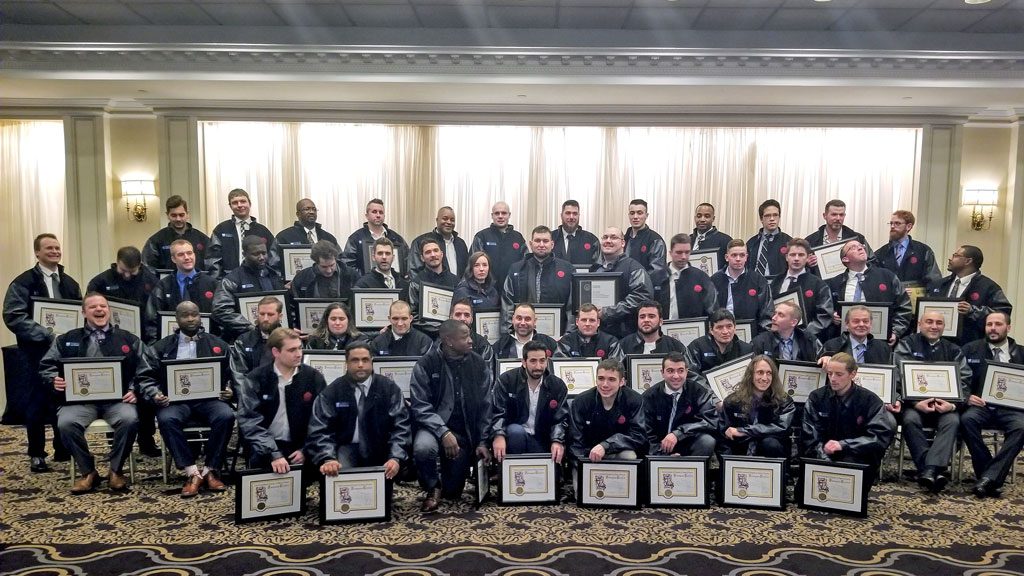Make big plans.
That was the message Mike Yorke, president of Carpenters’ Union Local 27, told graduates at the College of Carpenters and Allied Trades (CCAT) 2018 apprenticeship graduation ceremony held recently in Concord, Ont.
“I love that line that says ‘dream big, think big’ because that’s what our industry is all about,” said Yorke. “That is your role from here on in, to make big plans. This union came from big plans. The CCAT, it also came from big plans, and the city that you will build from here on out, that’s going to be from big plans too and you are going to play a role in it.”
He congratulated the graduates on their hard work and pointed out while the industry is evolving, training is still key.
“Our commitment is to deliver the best job at the best price, the most productive workers and that is what you are going to be, that is your goal and your responsibility out there,” he said.
“You are starting a new stage in your career. You’ve got four or five years of apprenticeship behind you, now you’re going out in the industry. There is probably a lot more expected of you. Gone are the days when you can say I’m only a second or third year apprentice I shouldn’t have to know how to do that, now the challenge is you’ve got to know and you’ve got to deliver. We know that you will.”
He pointed out the industry is strong right now with some of the largest jobs happening in the Greater Toronto Area.
“We have some of the coolest jobs in Canada happening right here with CIBC Square, the Vaughan hospital, Eglinton Crosstown, you can play a role in all that,” said Yorke. “That is what building a city is all about and that is our role as an organization and individuals. I am asking you to take the opportunity to lead, to build and to create your own legacy.”
Ontario’s Chief Prevention Officer Ron Kelusky was the guest speaker at the event. He conveyed the importance of safety to the new graduates.
“As the chief prevention officer, my role is to talk about safety and to ensure that when you go out there and you work for an employer and you are affiliated with an organization, that organization takes your safety very seriously and equally that you take your safety seriously. We want to make sure that your long career is in fact that, a long career,” said Kelusky.
Compared to other sectors, Ontario’s construction industry has one of the highest rates of workplace injuries and fatalities. The Construction Safety Action Plan, which was developed in close partnership with labour and employers, includes a series of recommendations.
“I’ve made a commitment to everybody on the committee that I don’t want this to be another glossy report that goes nowhere,” said Kelusky. “This committee will stay active until we get the job done. There are a number of initiatives to support the action plan that have already been implemented but there is still a lot of work to be done because no industry should be unsafe.”
He also said developing a Working at Heights standard is not enough and it needs to be reviewed.
“We’re trying to look at whether or not it makes a difference,” said Kelusky. “It’s not just as simple as saying we trained 500,000 people, that’s a really good statistic and then walk away. That’s an output. We’ve got to start looking more importantly at outcomes. The outcomes we want to look at is are there fewer fatalities, are there fewer criticals, are there fewer injuries?”
A study was also conducted to determine why injuries and fatalities happen, he noted.
“What we found is the majority of people who died weren’t wearing fall protection,” said Kelusky. “Then we looked deeper and found that a majority of people died working for a company with five or less people. Fifteen per cent of the people who died, died in their first month of work.
“We also found that 18 per cent of the people that died, died from a fall that was about three metres high.”
“Fatalities are not acceptable, critical injuries are not acceptable and lost time injuries are not acceptable,” he added. “I’m not saying we could eradicate it completely. It’s not impossible to be safe, it’s a culture, it’s a process. I know we can.”





Recent Comments